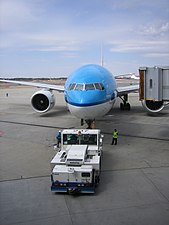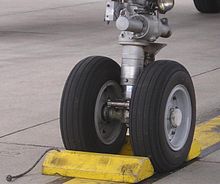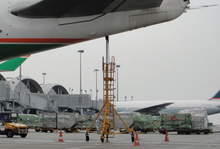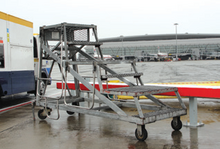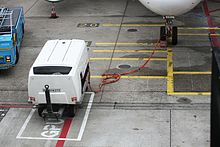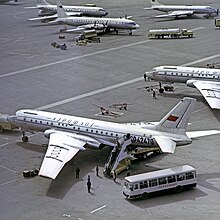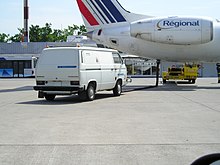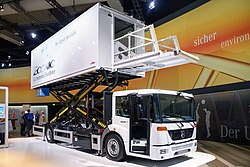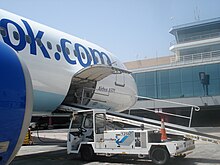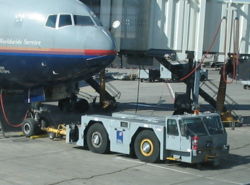
An airport is an aerodrome with extended facilities, mostly for commercial air transport. Airports usually consist of a landing area, which comprises an aerially accessible open space including at least one operationally active surface such as a runway for a plane to take off and to land or a helipad, and often includes adjacent utility buildings such as control towers, hangars and terminals, to maintain and monitor aircraft. Larger airports may have airport aprons, taxiway bridges, air traffic control centres, passenger facilities such as restaurants and lounges, and emergency services. In some countries, the US in particular, airports also typically have one or more fixed-base operators, serving general aviation.
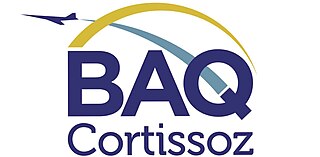
Ernesto Cortissoz International Airport is an international airport serving the area of Barranquilla, the capital city of the Atlántico department in Colombia. The airport is located in the suburban municipality of Soledad. It owes its name to one of the pioneers of Colombian aviation, Ernesto Cortissoz.

In transportation, freight refers to goods conveyed by land, water or air, while cargo refers specifically to freight when conveyed via water or air. In economics, freight refers to goods transported at a freight rate for commercial gain. The term cargo is also used in case of goods in the cold-chain, because the perishable inventory is always in transit towards a final end-use, even when it is held in cold storage or other similar climate-controlled facilities, including warehouses.

Grand Forks International Airport is a public airport five miles (8 km) northwest of Grand Forks, in Grand Forks County, North Dakota, United States. GFK has no scheduled passenger flights out of the country but has an "international" title because it has customs service for arrivals from Canada and other countries.
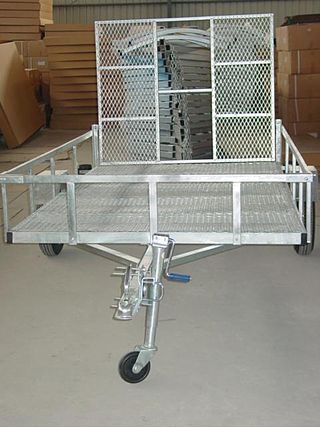
A trailer is an unpowered vehicle towed by a powered vehicle. It is commonly used for the transport of goods and materials.
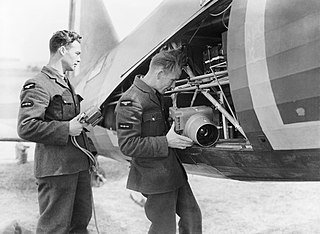
In all forms of aviation, ground crew are personnel that service aircraft while on the ground, during routine turn-around; as opposed to aircrew, who operate all aspects of an aircraft whilst in flight. The term ground crew is used by both civilian commercial airlines and in military aviation.

SATS Ltd. (SATS), an acronym derived from Singapore Airport Terminal Services, is a Singaporean airport service company that handles the main ground handling and in-flight catering service provider at its country's Changi Airport. SATS controls about 80% of Changi Airport's ground handling and catering business.

In aviation, aircraft ground handling or ground operations defines the servicing of an aircraft while it is on the ground and (usually) parked at a terminal gate of an airport.

In the airline industry, a baggage handler is a person who loads and unloads baggage, and other cargo for transport via aircraft. With most airlines, the formal job title is "fleet service agent/clerk", though the position is commonly known amongst airline employees as a "ramp agent", due to the job's location on the airport ramp (tarmac).
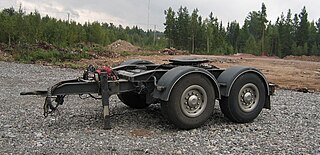
A dolly is an unpowered vehicle designed for connection to a tractor unit, truck or prime mover vehicle with strong traction power.

A semi-trailer is a trailer without a front axle. The combination of a semi-trailer and a tractor truck is called a semi-trailer truck.
IATA delay codes were created to standardise the reporting by airlines of commercial flight departure delays. Previously, every airline had its own system, which made the sharing and aggregation of flight delay information difficult. IATA standardised the flight delay reporting format by using codes that attribute cause and responsibility for the delay; this supports aviation administration and logistics and helps to define any penalties arising. These codes are used in movement messages sent electronically by SITA from the departure airport to the destination airport and also in the internal administration of the airlines, airports and ground handling agents.
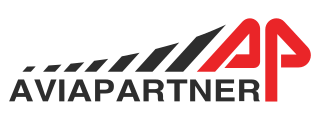
Aviapartner, whose origins date back to 1949 under the name of Herfurth Air Services to become 'Belgavia' in the late 1960s, is a Belgian company that provides ground handling services at 37 airports in Belgium, France, Germany, Italy, Spain and The Netherlands. Among the airports served are Amsterdam, Brussels, Milan, Düsseldorf, Rome, Nice, Toulouse and Málaga.

Tiruchirappalli International Airport is an international airport serving Tiruchirappalli in the Indian state of Tamil Nadu. The airport, spread over an area of 702.02 acres (284.10 ha), is located on National Highway 336, about 5 km (3.1 mi) south of the city centre. As of 2022, it is 31st busiest airport in India for passengers handled and 11th busiest for total international aircraft movement. It is the third busiest airport within Tamil Nadu in terms of total passenger traffic, after Chennai and Coimbatore.

Baggage carts, luggage carts, luggage trolleys or trolleys are small vehicles pushed by travelers (human-powered) to carry individual luggage, mostly suitcases. There are two major sizes: One for big luggage and one for small luggage. Carts have usually two parts for carrying luggage: A small section (basket) for carry on luggage at the same level as the handle, and a lowered large section for suitcases a small and large bags.

Material handling equipment (MHE) is mechanical equipment used for the movement, storage, control, and protection of materials, goods and products throughout the process of manufacturing, distribution, consumption, and disposal. The different types of equipment can be classified into four major categories: transport equipment, positioning equipment, unit load formation equipment, and storage equipment.

The Lockheed "Flatbed" was a proposed cargo aircraft design from the 1980s that mounted large loads "in the open" on the back of the aircraft, similar to a flatbed truck. The name "flatbed" was unofficial, as a more formal name was never assigned. Although there was a fair amount of public information released about the design in the early 1980s, the design was never picked up by the US Air Force and disappeared by the mid-80s.
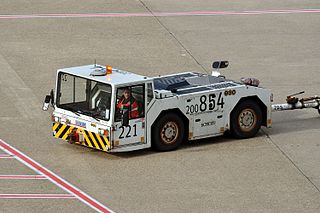
SCHOPF Maschinenbau GmbH is a German company that produces specialist vehicles for the mining and aviation industries.

Hong Kong Airport Services Limited(HAS) was founded in 1995 and began operations in July 1998 with the opening of Hong Kong International Airport. It employs approximately 3,100 people and owns 3,000 ground-support equipment and vehicles. It is owned by Cathay Pacific, with offices located at Cathay City, Cathay House, Passenger Terminal Building and Cathay Pacific Cargo Terminal.
Airport dollies for unit load device (ULD) and cargo pallets are standard sized flatbed trolley or platform, with many wheels, roller bars or ball bearings protruding above the top surface for easy loading and unloading of ULD and cargo pallets respectively. Since ULD/pallet rest on ball bearings, these dollies are equipped with hinge/locks to secure the position of the ULD/pallet on them during tugging transportation. The aviation industry adopted ULD/pallets to be lightweight containers and supporting platforms respectively, intended to be loaded into aircraft and fly along with their loads, they need to be minimum in weight and thus do not have wheels or strong base structure. Also, the ULD/pallets have stringent dimensional standard following the aircraft cargo bay dimension. Therefore, these dollies are custom designed to complement the ULD/pallet's dimension, hinge/fixture position, weak overall physical strength and transportation need. Advanced dollies for ULD and pallets, such as those used on an airport apron, may have the following specialized facilities:


